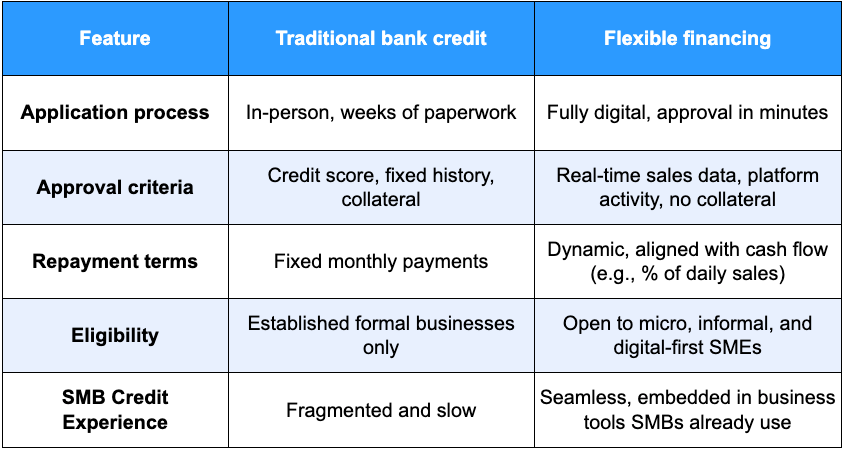Small and medium-sized businesses (SMBs) form the heartbeat of Latin America’s economy. From independent delivery couriers to fast-scaling e-commerce brands, they make up more than 95% of businesses and over 60% of employment. Yet, when it comes to financing growth, they often hit a wall: traditional banks.
Rigid terms, long wait times, and outdated risk models leave too many promising businesses behind. In contrast, flexible financing—offered by fintechs and through digital platforms—is rapidly becoming the go-to growth solution across sectors like retail,logistics, and marketplaces.
This article explores how flexible financing compares to traditional credit, with real stories from entrepreneurs, industry-specific insights, and a breakdown of why this model is critical to SMB growth in 2025 and beyond.
When we talk about access to capital, it’s not just about getting a loan—it’s about how the process, terms, and structure of that loan impact the day-to-day operations and future potential of a business. The following comparison outlines the core contrasts between legacy credit systems and modern, flexible finance. It shows why traditional financing often excludes digital-first SMBs and why adaptable models are redefining the future of business growth in Latin America.

This side-by-side comparison highlights why traditional banking is often incompatible with the realities of growing businesses in LatAm. Retailers, couriers, and service providers need speed, simplicity, and financing that moves with them.
Flexible financing refers to innovative funding models that adjust to how a business actually operates. Instead of imposing rigid repayment and underwriting requirements, these models meet the entrepreneur where they are. Key examples include:
These tools are designed for real-world volatility. If a business earns less one week, it pays less. If it earns more, repayment accelerates—making growth sustainable, not stressful
Ana runs a cosmetics brand that sells through a large online marketplace. Every holiday season, she sees a surge in demand—but in 2024, she didn’t have the capital to scale her inventory on time.
Her bank turned her down. She lacked two years of financial statements and didn’t have real estate as collateral. Even if she had qualified, the process would have taken at least a month—time she simply didn’t have during her busiest season. The urgency of the opportunity excluded her from a system designed for slower, more traditional businesses.
Through the e-commerce platform, she received a revenue-based financing offer. The funds landed in her account in 24 hours. Instead of fixed monthly payments, she repaid a small cut of her daily sales. No penalties. No stress.
With that funding, Ana increased her stock threefold and grew her seasonal revenue by 160%. Within three months, she had repaid the full amount.
Flexible financing didn’t just save the season—it helped her break into a new revenue tier.
Carlos manages a network of 30,000 delivery drivers in Lima. He noticed that many of them were struggling to keep their bikes and phones in working condition. Replacing a tire or upgrading a phone could mean missing an entire week of work.
Banks wouldn’t even consider microloans of $100 or $300—especially for independent contractors.
Carlos integrated a fintech-backed embedded lending solution into the delivery platform in under a week, with no disruption to operations. Drivers could access microloans instantly based on their delivery history and repay them gradually from their earnings.
Drivers could access microloans instantly based on their delivery history and repay them gradually from their earnings.
Within two months, uptime increased, driver retention improved, and total order volume jumped by 22%.
Unlike traditional credit, flexible financing is:
According to Helmi Group, fintech lenders using transaction-based underwriting approve up to 60% more loans for SMBs in Latin America compared to traditional banks.
Retail & e-commerce. BNPL tools for inventory, RBF for seasonal cash flow, short-term loans to support marketing campaigns.
Delivery & logistics. Microloans for vehicle repair, phones, or gas—repaid from weekly income.
Hospitality & food service. Embedded lending to fund off-season renovations or cover rising input costs.
Construction & home services. Flexible supplier financing and installment tools for materials.
Digital creators. Advances based on platform earnings or sponsorship contracts.
In all of these cases, the principle is the same: capital that follows your revenue, not rules written decades ago.
Digital platforms are becoming much more than marketplaces or tools—they’re ecosystems. By integrating financing directly into their products, they:
For users, the experience is just as powerful. There’s no need to leave the app, prepare a pitch, or wait for approval. Financing becomes part of the journey, not a separate step.
At R2, we help platforms operating in Latin America offer seamless, embedded financing solutions tailored to their clients; such as SMBs or professionals using your platform to sell. We work across industries to:
We don’t just help platforms grow—we help your ecosystem thrive.
Ready to scale without banks?
If your platform customers (sellers) need capital to grow, retain talent, or unlock new inventory, we’re ready to help. Explore more about the credit gap which is why embedded finance is transforming the lending landscape in Latin America with our one-pager.
Contact our team or email us at partners@r2.co to learn how embedded finance can power your platform’s growth.